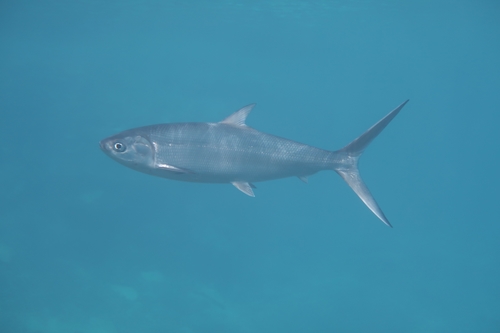
Milkfish
Bluefin tuna, belonging to the genus Thunnus, are among the most remarkable fish in the ocean. Known for their incredible speed, size, and commercial value, they play a crucial role in marine ecosystems and human economies. This article delves into their characteristics and importance.
5 15 years
Lifespan
180 cm
Length
Least Concern
Conservation Status
50 km/h
Swimming speed
Omnivorous, Detritivorous, Filter Feeding
Diet
Diadromous Migration - Catadromous, Estuarine Migration
Migration
Appearance Overview
The Bluefin Tuna is renowned for its large, streamlined body, built for speed and endurance.
Color
Dark metallic blue on top with a silvery underside
Fins
Two dorsal fins, with the second being taller than the first
Body Shape
Torpedo-shaped body optimized for efficient swimming
Length
Up to 10 feet (3 meters), commonly around 6.5 feet (2 meters)
Weight
Up to 1,500 lbs (680 kg), commonly around 550 lbs (250 kg)
Diet
Carnivorous, feeding on fish, squid, crustaceans, and occasionally on eel and starfish.
Feeding Behavior
Uses speed to chase down prey, sometimes in coordinated schools, exhibiting opportunistic feeding habits.
Social Behavior
Highly migratory, forming large schools, particularly during spawning season. These schools can be segregated by fish size.
Commercial Relevance
Extremely high value, especially in sushi and sashimi markets, where it is considered a delicacy.
Conservation measures
Fishing quotas, restrictions on fishing gear, and international agreements to manage stocks, marine protected areas.
Status
Varies by species: Atlantic Bluefin Tuna is Endangered, Pacific Bluefin Tuna is Vulnerable, and Southern Bluefin Tuna is Critically Endangered.
Threats
Overfishing remains the primary threat, exacerbated by illegal and unreported fishing; climate change also affects migration and prey availability.
Habitat Distribution
Depth Range
0-1,000 meters, though they are often found in surface waters.
Geographic Range
Atlantic Ocean, Pacific Ocean, Indian Ocean, and the Mediterranean Sea.
Preferred Environment
Temperate and subtropical waters, open ocean, often near continental shelves and slopes.
Reproduction and Life Cycle
Breeding Habits
Spawns in warm, specific areas such as the Gulf of Mexico and the Mediterranean Sea, with spawning seasons varying by location.
Development Stages
Larvae hatch in plankton-rich waters and grow rapidly, transitioning through juvenile stages before reaching adulthood.
Fecundity
Females can produce a large number of eggs, up to 30 million per season, depending on their size and condition.
Maturity Age
Varies by species; Atlantic Bluefin Tuna typically mature at 4-8 years, Pacific at 5-7 years, and Southern at 8-12 years.
Faqs about Milkfish
How fast can Bluefin tuna swim?
Bluefin tuna are among the fastest fish in the ocean, capable of reaching speeds up to 43 mph (70 km/h).
What is the lifespan of a Bluefin tuna?
They can live up to 40 years, though this varies slightly between the different Bluefin species.
Are Bluefin tuna warm-blooded?
Yes, they are warm-blooded, which allows them to maintain a higher body temperature than the surrounding water, aiding in muscle efficiency.
Why do Bluefin tuna have such a varied diet?
Their warm-blooded nature and high metabolic rate require large amounts of food, leading them to consume a wide variety of prey.
Why is Bluefin tuna conservation so important?
The high demand for Bluefin tuna, particularly in sushi markets, drives overfishing and high prices, making conservation challenging.
At what age do Bluefin tuna reach maturity?
Atlantic Bluefin Tuna mature at around 4-8 years, while Pacific and Southern Bluefin Tuna mature later.
Where are Bluefin tuna found?
Bluefin tuna are found in the Atlantic, Pacific, and Indian Oceans, as well as the Mediterranean Sea.
Do Bluefin tuna migrate?
Bluefin tuna undertake long migrations across oceans for feeding and spawning.
Copyright @ Nature Style Limited. All Rights Reserved.
 English
English